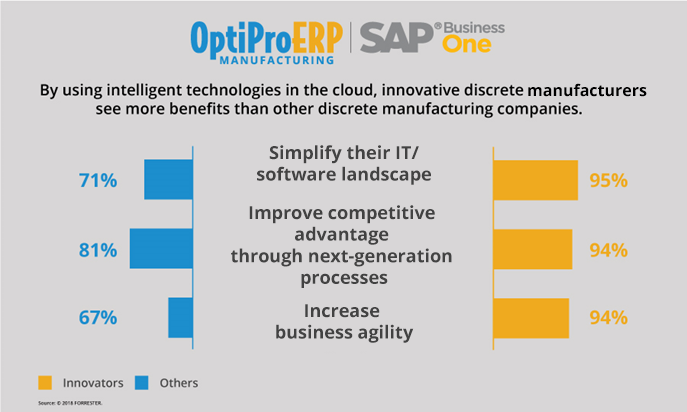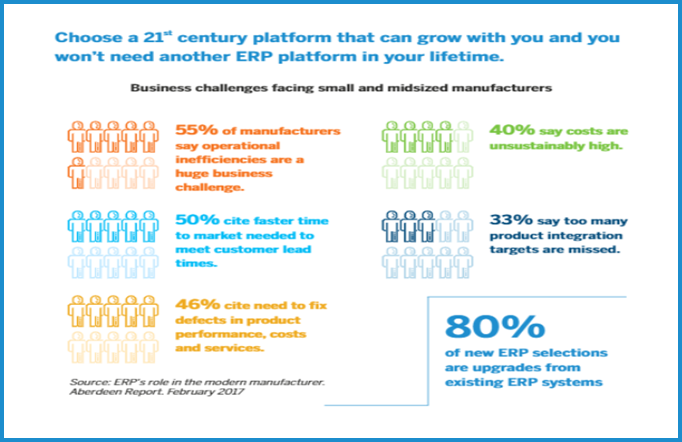It’s more important than ever for manufacturers to find ways to effectively manage their operations in the face of Covid-19, supply chain disruptions, inflation concerns, glimpses of recovery, and the many dynamics impacting manufacturers’ bottom lines. A survey from the Institute for Supply Management shows almost 75% of organizations reported supply disruptions, and 16% of those companies have adjusted their revenue downwards.
Leveraging an ERP solution provides manufacturing companies more flexibility and deeper control over business processes with advanced supply chain management capabilities to navigate these challenges and increase efficiency, productivity, and profitability. The right ERP system helps manufacturers remain agile and resilient to mitigate risk. It will also help manage, track, coordinate, and connect dynamic manufacturing processes.
That is why the stakes of selecting the right ERP system for your business has also increased, and it is never a bad time to revisit the core steps to selecting the right ERP system for your manufacturing business.
Steps to take when choosing an ERP system
It’s important to ensure you use a proven method for evaluating ERP systems to avoid time-consuming and expensive customizations, implementation delays, and system replacements. There are hundreds of ERP solutions to choose from and having so many options can seem daunting.
It’s essential to create a core team that will drive the ERP comparison, selection, and implementation process. The selection team should include a mix of management, functional business leads, and Subject Matter Experts (SMEs) who understand the upstream and downstream processes and impacts of their respective departments.
Ensure your team members are committed to the process, understand the organization well, and have the time to commit to this project. The team begins its work by developing an initial plan which is really a general strategy at first.
The ERP selection process outlined in these five essential steps will help your team choose the best ERP system for your business and avoid costly mistakes.
1. Define your ERP requirements
The first step in the ERP selection process is to outline the challenges you face as a company that you want this new system to help you overcome. Pull together resources that help define your company, such as product specs, process flows, and high-level data maps. Also, gather data such as the size of your organization, volume of activities and transactions, business processes, unique requirements, as well as features you like and don’t like about your current system(s). You can categorize requirements as:
- The description and nuances of your business and high-level or unique process flows
- What your current system does well for you
- What it does not do that you would like it to do
- What else you want the new system to do (ranked by importance)
It’s important to really nail down what is essential to your organization to help prospective ERP vendors understand your business needs now and for the future. However, avoid long lists of specific requirements and detailed processes, rather focus on things that are unique to your business and requirements that will provide your business with a competitive edge.
2. Creating the ERP RFP
When looking at ERP providers, notice their ranking and reviews to see how other companies have rated them. Choose 12 or fewer vendors whose products look like they may be a good fit for your organization. Send out requests for proposals (RFPs) with a detailed review of your needs as noted above. Ensure everyone on the team has provided input to ensure you have the full scope of your core business requirements. Then determine priorities that are aligned with your main business goals.
ROI analysis is also a prerequisite for authorizing and funding ERP solutions. It will provide an idea about the total investment required for the purchase, implementation, and ongoing support and maintenance of your ERP system. ROI considers the benefits in addition to direct cost savings including improved performance, better customer service, and enhanced workplace productivity, and the resulting top and bottom line impacts of these benefits.
3. First-cut ERP evaluation
Once you have selected the ERP providers you are interested in, gather proposals from each based on your business needs. Eliminate those options that don’t meet your selection criteria. Utilizing a numeric rating scale will help make the decision process easier.
Make sure you treat every potential provider equally and that all people on the team work together to ensure nothing is missed. If reviewers are at odds with their ratings, get to the bottom of why, and work constructively to sort out any adjustments needed.
4. ERP demo comparison and detailed evaluation
Narrow your choice of prospective vendors to three to five finalists and then move to the demo process. Schedule demos with each of the selected vendors and feel free to let them know who they are competing against. Keep control over the demos by providing a list of functions you want to see well in advance of the demo.
The sales professionals and engineers who demonstrate software are very experienced trying to win you over to sell their software. No matter how hard they try to convince you about the software, make sure to objectively focus on the functionality offered.
Ensure you address any concerns you have and take good notes. It’s important to do your due diligence to ensure you understand everything you need to know about the functionality, underlying technology, and performance of the system.
If looking at a cloud based erp system, determine if it is a true, native cloud solution that takes full advantage of this delivery model. Also assess how much each vendor has invested in R&D and product development and innovation to ensure their product continues to meet the needs of today’s and tomorrow’s digital world.
Don’t be afraid to ask questions to ensure you fully understand if the ERP system can fulfill your business needs. Sometimes you will need multiple rounds of demos to look in depth at all of the functionality that is important to the team.
5. Final selection and contract
Final evaluations and a detailed comparison may leave you with two or three ERP options that can meet your business requirements and budget. Let the vendors know where they stand, but don’t close any doors in case negotiations with your top choice does not work out. Work with your top vendor to come to a fair deal and treat them as a partner who is involved in your future success. Remember that having a successful implementation relies on the cooperation and partnership of both parties.
From there you proceed with checking out references and finalizing the contract, hopefully with the vendor of choice that offers the best ERP solution for your particular manufacturing business.
A few more criteria to consider
In addition to what has already been mentioned, here are some other important criteria to consider when choosing a manufacturing ERP system in today’s ever-changing and digital world.
Look for a modern manufacturing-focused ERP solution
The manufacturing world thrives on innovative technology. Modern manufacturing ERP software is scalable and grows with your business. It uses the latest technologies such as AI, Machine Learning, Advanced Analytics, and IoT to provide a platform for growth and agility in the digital economy. And, it delivers functionality that addresses your unique business and industry needs. By delivering a future-proof platform, a modern manufacturing ERP system will unlock growth, efficiency, productivity, and cost savings.


Choose an industry-specific ERP solution
It is advised to eliminate those ERP providers who insist they can mold their software according to your industry and business processes. True industry-specific ERPs ensure increased visibility, automation, collaboration, and real-time information for intelligent decision-making, and most importantly, without third-party add-ons or heavy customizations.
Manufacturing ERP provides deeper and more advanced functionality for manufacturing and sub-industry needs. Some of these functions include Production Management, Advanced Planning and Scheduling, Manufacturing and Shop Floor Execution, Product Configurator, Supply Chain Management, Warehouse Management, Quality Management, and more. Such ERP systems provide deeper functionality for discrete, process, and mixed manufacturing models.
Select an ERP partner with deep industry experience
The ERP partner you choose should be ready to help and advise you during every step, from selection to business process improvement and transformation, implementation, system integration, to go-live, and post-implementation customer support. They should deliver industry-specific knowledge and expertise, as well as functionality.
Find a sized-right ERP solution
You should make the final decision for your ERP selection keeping in mind the size and nature of your business. If you run a small or mid-sized manufacturing organization, you want a system that will fit your needs now, but also that can grow with your organization. But, don’t get sold on a system that is too large for your needs. Look for a system that will provide easy-to-use interfaces and dashboards and a streamlined structure to drive increased usage and adoption across your company users.
Consider a cloud-based ERP system
Customers are increasingly seeking faster delivery of goods/services, greater reliability, increased customizations, and lower costs.
A cloud ERP enables the tracking of orders, material, machine availability, tasks, and capacity via hand-held devices so managers don’t have to be present on the shop floor to manage, monitor, and assign tasks.
With a cloud ERP, you can create, edit and manage real-time reports and evaluate pre-determined KPIs to assess cash flow, inventory availability and costs, and pricing strategies all in a secure environment. More and more businesses are finding the cloud their preferred option.
Conclusion
Whether you are investing in an ERP for the first time or replacing your legacy system, make sure you define your ERP selection criteria checklist and are able to clearly communicate it to vendors. Be sure to:
1) Review whether you want cloud, on-premise, or a hybrid deployment as well as how many users will use the system
2) Assess your budget, total cost of ownership (TCO), and return on investment (ROI)
3) Strongly consider the underlying technology, future scalability, functionality, and necessary customizations of the system
Utilizing these essential five steps to select an ERP will keep you focused on the important things, shorten your timeline for selection, and help you choose the right ERP system for your business.
Follow Us










